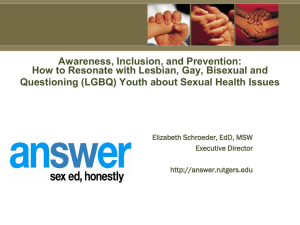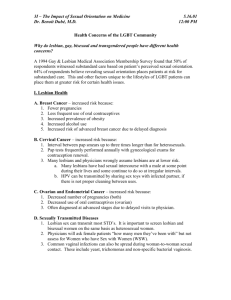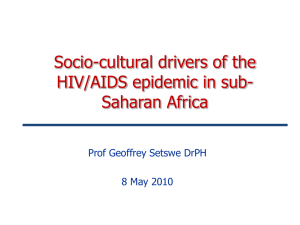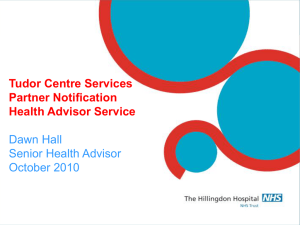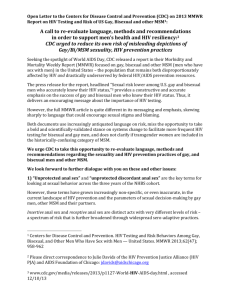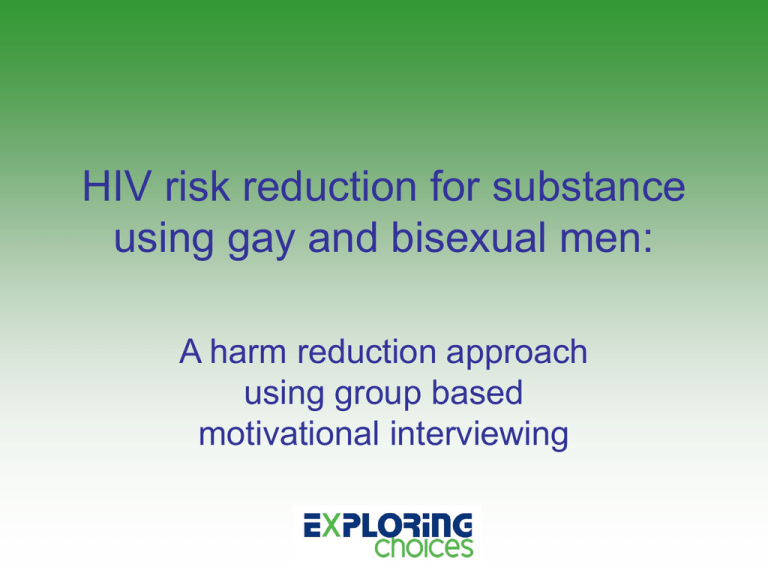
HIV risk reduction for substance
using gay and bisexual men:
A harm reduction approach
using group based
motivational interviewing
Research Team
•
•
•
•
•
Tim Guimond, CAMH
Carol Strike, CAMH
David Brennan, U of T
James Murray, AIDS Bureau
Jean Pierre Londono Sanchez,
CAMH
• Jim Cullen, CAMH
• Karen de Prinse, Casey House
•
•
•
•
•
•
•
•
Kenneth Tong, Community
Le-Ann Dolan, ACT
Mark Hallman, SMH
Maureen Mahan, Casey House
Nick Boyce, Fife House
Peggy Millson, U of T
Tarry Steckly, Community
Winston Husbands, ACT
Rationale
• Studies link alcohol and drug consumption with unsafe sexual
behaviours among gay/bisexual men
• Higher rates of alcohol and drug consumption have been
documented amongst gay and bisexual men
• Alcohol and drug treatment may reduce risks but few men attend
treatment
• Motivational interviewing (MI) shows great promise for behavioural
change, including sexual and drug and alcohol consumption
• MI – client centred, non-judgmental approach focused on assisting
individuals to resolve ambivalence toward behaviour change
Project objectives
• Develop a transdisciplinary team including researchers, clinicians,
community-based service providers, policy-makers and community
members
• Develop an intervention model suitable for community-based settings
• Build capacity for group interventions, MI, knowledge sharing and
collaboration
• Complete a pilot study of the intervention.
Research questions
Primary
• Does group-based motivational interviewing with a harm reduction
focus result in reductions in high HIV-risk sexual behaviours
(unprotected anal intercourse)?
Secondary questions/outcomes:
• Are reductions in sexual HIV risk behaviours (if any) mediated by
overall reductions in substance use OR situational substance use
proximal to sexual activity?
• Are there differences between HIV-positive and HIV-negative men in
terms of the impact of group based MI on sexual risk reduction?
• Does it make a difference if groups are mixed serostatus vs. similar
serostatus?
Research questions
Process/KTE outcomes:
• What elements of training, supervision, review and case
discussions appear most advantageous in the successful
adaptation of motivational interviewing to HIV prevention
work?
• Do community workers trained in MI, find this approach to
be relevant to their other work?
• What knowledge, skills, references and supports do
community workers feel is necessary for successful
application of MI in their practice?
Study design
• Longitudinal intervention
conducted with 3 groups
(mixed serostatus; HIV
negative; HIV positive)
• Inclusion criteria
– Age 18 or older
– In past 60 days, had unprotected
anal intercourse with a man while
drunk or high
– English speaking
– Self identify as gay or bisexual
• Exclusion criteria
– Non-substance induced
psychotic disorder
– Actively suicidal
– Partner, lover, boyfriend of
another study participant
• N=24 – three groups of 8 men
Recruitment
58
17
Could not be
reached
# of Contacts
41
Were screened
16
Did not meet eligibility
criteria
25
Were eligible
17
HIV-positive
8
HIV-negative
Measures
•
•
•
Demographics
Sexual orientation and HIV status
Mental health – SCID substance dependence, Beck Depression,
Penn State Worry Questionnaire, Social adjustment scale,
internalized homophobia scale, HIV knowledge
Readiness ruler for behavioural change
•
–
–
•
drugs, sexual behaviour in general, unprotected anal intercourse
Importance, confidence, realistic
Timeline follow-back - unprotected sexual events
–
–
–
–
Gender, HIV status, casual or a regular partner
Sexual behaviours, condom use, location - bathhouse
Drug use before or during sex with this partner
Alcohol consumption before or during sex with this partner
7 wk group based MI using a harm
reduction model
• GOAL:
– Help gay, bi men who use drugs and/or alcohol lead balanced healthy and
fulfilling lives by considering the roles drugs play in their life and how to reduce
the risks to themselves, their loved ones and the community.
• Schedule
–
–
–
–
–
–
Baseline research interview (paid)
Individual pre-group meeting with facilitators to define goals and expectations
7 group sessions lasting 1.5 hours
Exit interview with facilitators
End of intervention research interview (paid)
3 month follow-up research interview (paid)
Intervention
• Week 1
• Introductions, norms/expectations of the group
• What drugs do we use, like and dislike
• Week 2: How drugs fit in my life
• Benefits, impacts and costs of drugs in our lives & those we love
• Harm reduction information will be integrated into conversation in
this week and next week
• Week 3: How drugs fit in my life
• Share information about different substances, dispelling myths,
harm reduction strategies
Intervention
• Week 4 – Drugs, sex and sexuality
– How drugs fit into our sex lives
– Role of drugs, sex and identity in the community
– HIV and sexual risk taking and drugs
• Week 5 – When this much is too much
– Discussion of dependence and drug-related harms
– Decisional balance exercise
Intervention
• Week 6 – Setting my goals
– Next steps and goal setting
– What might get in the way of this?
• Week 7 – My community & closing
–
–
–
–
How will this work with my friends, my community?
What can we be doing to help those close to us?
What can we be doing to help others in the community?
Say goodbye
Baseline data on subjects recruited to date
• Five individuals withdrew/were deemed ineligible at
baseline hence 20 people are included here:
• Age: average 44.3 (s.d. 10.9)
• 16 were HIV-positive
• 18 identified as gay, 1 as bisexual, and 1 as twospirited
• 17 reported they were single/never married, 2 as
separated, and 1 as divorced
Baseline demographics (continued)
• Highest level of education: 2 some high school, 1
completed high school, 5 some college or
university, 2 completed community college, 8
completed university, 2 other
• Employment: 1 works full-time, 6 work part-time, 9
not-employed or on disability, 1 self-employed, 3
other (one is a current student)
• Income: average $11,234 (s.d. $11,358)
Baseline data (continued)
• Beck Depression Inventory: avg 16.5 (s.d. 9.8)
[n=15]
• 6 (30%) reported physical abuse as a child
• 2 (10%) reported being sexually abused as a child
by a female offender and 9 (45%) by a male
offender
Lessons learned: Recruitment
• Recruitment of HIV – positive subjects was much
easier through existing networks of care providers
• HIV – negative subjects were much more likely to
be marginally housed, and therefore to have less
stable contact numbers making it difficult to followup with these individuals
• Different strategies necessary for HIV – negative
men
Successes to date - KTE
• Participation in training indicative of interest and need for
MI within the community
• Congruency between counseling approaches used by our
community partners and motivational interviewing
• Interest in extending MI approach to other programming
areas within ASOs
• Success with MI approach has positively influenced the
ways in which education and outreach are viewed by staff
Successes to date : KTE 2
• Training model
– Breaking up training over several weeks allows participants to
practice integrating the principles from early on in the training
– Improved uptake of MI principles and practices
• Integration of clinical supervision into the training and
especially into the group process has proven quite valuable
to facilitators in developing MI facility
• Inviting other community agencies to attend free training
extended the benefits beyond the focal team to other
agencies
Moving forward
• Recruit and conduct group #3
• Review successes and challenges
• Develop strategies to overcome challenges of the
group format for implementation in the community
• Expand community partnerships for a larger
intervention study – extend east, west and north
• Consider option of also testing a briefer 1-on-1
model


